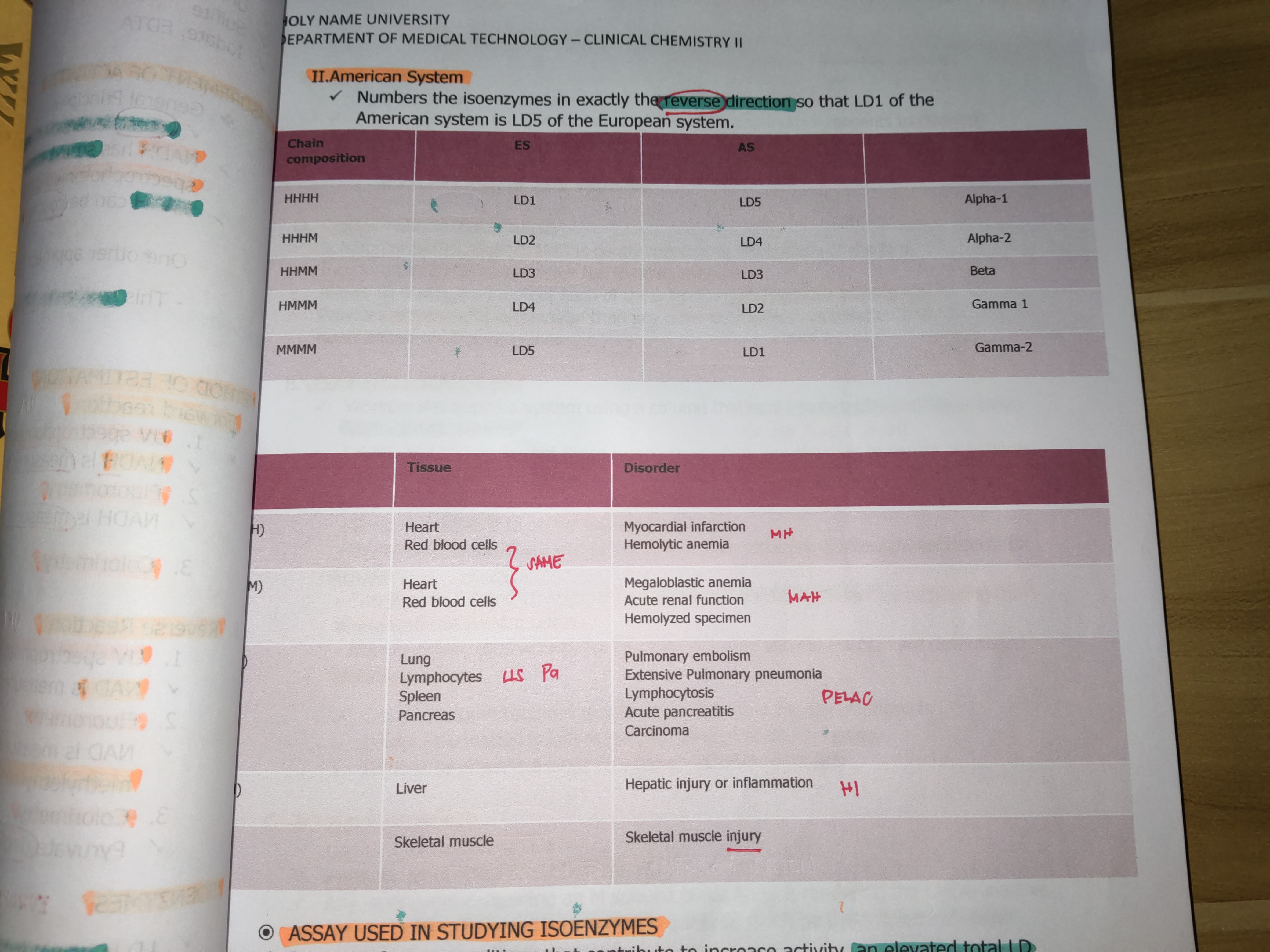LACTATE DEHYDROGENASE
1/49
There's no tags or description
Looks like no tags are added yet.
Name | Mastery | Learn | Test | Matching | Spaced |
|---|
No study sessions yet.
50 Terms
L-lactate: NAD Oxidoreductase
Other name of LDH
1.1.1.27
E.C of LDH
oxidoreductase
Belonging to the class ?
hydrogen acceptor or as coenzyme
Hydrogen transfer enzyme that catalyzes the oxidation of L-lactate to pyruvate with the mediation of NAD as ?
LDH
the reaction is reversible and strongly favors as the reduction of pyruvate to lactate
NAD+
Uses ? as cofactor
Embden-Meyerhof pathway
In the body, pyruvate is formed as end product of the ? which converts glucose to energy
heart and liver
RBCs
Skeletal muscle and kidney
WBCs
TISSUE DISTRIBUTION
High concentrations are found in the ?
Significant amounts are present in ?
? also contain considerable concentration
Also found in ?
lungs
smooth muscles
brain
Lesser amount in:
100-150x
Hemolysis produces an artefactual increase in serum levels; ? greater activity in RBC than serum
Serum
What is the sample choice?
Hemolysis
? must be avoided
Freezing
? may distort the isoenzymes distribution markedly
CSF and urine
Other body fluids as sample:
Activators
SH-
Inhibitors
Mercuric chloride
N-ethymaleimide (NEM)
Chloromercuribenzoate
Borate or oxolate
Oxomate
Urea
Sulfite
Iodate, EDTA
NADH
Most determination are based on the detection of ? in the reaction.
direct spectrophotometric measurement
NADH has strong absorbance at 340 nm which permits ?
redox indicator
NADH can be coupled with a ?
p-nitrophenylhydrazine
One other approach utilizes ? to form a color complex.
This method is imprecise and is not employed by many laboratory
Forward reaction
Reverse reaction
METHOD OF ESTIMATION
methylethylketone (MEK)
In reverse reaction of fluorometry; NAD is measured by its fluorescence following the addition of ?
Colorimetry in reverse reaction
Pyruvate depletion is monitored by 2,4 dinitrophenylhydrazone
European System and American System
What are the methods/system used in measuring the isoenzymes?
Heart and Muscle
5
LD is basically made of 4 polypeptides comprised of two types of polypeptide chains designated as ?
This combined in ? arrangements to yield ? major isoenzyme fractions.
European System
based on how fast isoenzyme moves towards an anode
LD1
being the fastest moving
LD5
? being the slowest
American System
Numbers the isoenzymes in exactly the reverse direction so that LD1 of the American System is LD5 of the European system.

Enumerate and memorize the two tables under the American System
nonspecific finding
Because of many conditions that contribute to increase activity, an elevated total LD value is rather ?
separated into isoenzyme fractions
LD assays assume more clinical significance when ?
Electrophoresis
Column Chromatography
Immunoinhibition
Enumerate the assay used in studying isoenzymes:
Fluorometrically or colorimetrically
After electric separation, the isoenzyme can be detected either ?
Wacker Method (colorimetric)
Solution of buffer, lactate, NAD is gently rolled onto the surface of the film
Incubated at 30-37°C for 30 mins or more
Allows ID and quantitation of each of the 5 fractions through time consuming
Provides more useful information than any other methods for separation and quantitation of LD isoenzymes
Column Chromatography
Workers developed a system using a column that could isolate LD1 and LD2 along with CK-MB fraction
ion exchange column
Sample is applied to an ?
Tris buffer
Unwanted fractions are eluted with ? (containing a low concentration of NaCl)
increasing the amount of NaCl in the buffer
the desired CK and LD fractions are removed from the column by ?
Column Chromatography
Disadvantages:
Sample volume required is quite large with that for electrophoresis
Useful information is lost regarding damage to other tissues
Difficult to process a large number of samples efficiently
Immunoinhibition
Useful in detection of LD1
Antibody to M subunit of LD + sample
Any isoenzyme containing an M subunit binds Ab it rendering the CHON inactive
Since only LD1 does not contain the M subunit, it will be the only one showing activity when assayed for total LD
relative % of LD1
By comparing total activity, with or without antibody present in the sample, the ? can be determined
Immunoinhibition
Procedures are reasonably quick to perform and cost is in the same range as electrophoresis
Some data suggest that LD isoenzyme changes associated with MI measuring the relative amount of LD1 and LD2 by electrophoresis
Megaloblastic anemia
Widespread carcinomatosis, esp. hepatic metastases
Septic shock and hypoxia
Hepatitis
Renal infarction
Thrombotic Thrombocytopenic purpura
Enumerate the pronounced elevation (5 or more times Normal)
MI
Pulmonary infarction
Hemolytic conditions
Leukemia
IM
Delerium tremens
Muscular dystrophy
Enumerate the moderate elevation (3-5 times normal)
Most liver diseases
nephrotic syndrome
Hypothryoidism
Cholangitis
Enumerate slight elevation (up to 3 times normal)
100 - 150 x
approximately False High
Hemolysis
Erythrocytes contain an LDH concentration ? that found in serum ?
25°C and analyze 48 hours
If the sample cannot be analyzed immediately, it should be stored at ?
LDH 5
4°C than at 25°C
? is the most labile (loss of activity at ? )
Approximately 35-90 U/L
95-200 U/L
Reference Ranges:
Forward Reaction: ?
Reverse Reaction: ?